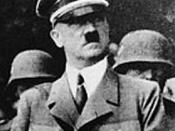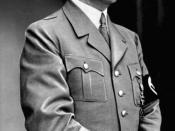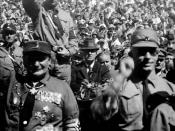In 1919 Hitler joined the DAP formed by Anton Drexler in the same year. Within two years he had control of the party. This was Hitler's first step to power. By this time the Twenty-five Points had been written. Source B summarises the Points. They may have reflected Hitler's own opinion but they were also a simple yet clever advertising stunt and it helped to increase the Nazi membership.
His second step was the Munich Putsch in 1923. Although this was a failure it showed that there was sympathy for him among the elite as he only served a few months of a five year sentence. When he was in prison Hitler made the decision to gain power by legal methods. Source C tells how Hitler felt:
'Instead of working to achieve power by armed coup, we shall have to hold out noses and enter the Reichstag...'
This shows us that the underlying principles behind Nazism did not change but the way at which they gained power did.
Hitler then tried to make the party into a more national organisation. The results of this can be seen in the increase of members throughout the 1920's as shown by Source D. He also used the new methods of communication work for him well. He organised mass rallies and utilised radio which issued the Nazi propaganda. Even though the propaganda was relentless it did very little to boost Hitler.
In 1929 Germany was badly affected by the Wall Street Crash as people turned to extremists to provide a solution. Hitler took advantage of this to attack the republic's economic and foreign policies with vigour. Despite all the extra support Hitler did not have the backing that he required to obtain a majority in the Reichstag. The depression had undermined the democracy and...


